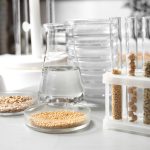SGS Crop Science Canada News: June 2022
In this edition of SGS Crop Science Canada News:
- Greenhouse Crop Nutrition – Managing Inputs
- Feed Expense Control – Action Items
- Field Pea Disease – Verification
- Utilizing Manure Nutrient – Data Benefits
GREENHOUSE CROP NUTRITION – MANAGING INPUTS
Running a greenhouse is a demanding business, and it’s easy to overlook the need to proactively monitor your resources. But, doing so is the best way of ensuring that the health of your plants is not impacted by nutritional imbalances.
With fertilizer prices rising dramatically, laboratory testing is a worthwhile investment to ensure adequate crop nutrition, and to make sure you can identify and address problems before they become too severe. For example, testing can confirm that a visual diagnosis of pale leaf margins is caused by a potassium deficiency, or that yellowing leaves are caused by chloride toxicity.
- Testing raw water with our Water Complete package determines background pH, EC, and nutrient levels. Solution Complete confirms the fertigation mix or can be used to balance re-circulated water.
- Other packages for greenhouse testing include Media Complete to determine nutrient levels and EC, and Tissue Complete to monitor plant nutrition or to confirm symptoms.
FEED EXPENSE CONTROL – ACTION ITEMS
With today’s multi year grain and oilseed high prices, testing of your forages and grains is essential to control feeding profitability for dairy and beef producers.
- Knowing the nutrient profile of your first cut haylage and hay, can help you reduce purchased feed costs. Testing your forages by either our NIR or Wet Chemistry methods is the first step, to building cost effective rations.
- To get the most value from processed grains that you feed to dairy and beef herds, consider our Fecal Starch Test. Collecting a composite fecal sample and sending it our lab can provide valuable insight on the starch digestibility through the digestive tract. Inadequate processing of your grain can be costing you money.
FIELD PEA DISEASE – VERIFICATION
Soil pathogens are known to be destructive to plant populations and health. If your field peas are not performing as expected, use our DNA tools to confidently identify or rule out Aphanomyces euteiches, an oomycete that invades root conductive tissue. The test result brings confidence to visual inspection and aids in the development of future crop rotational plans.
- Root rot causal agents are numerous and are difficult to identify when minimal root tissue remains. Order Aphanomyces PCR Detection, when you need to be sure.
- Seeking comprehensive analysis of your field soil? PCR Quantification of Aphanomyces builds strong agronomic information and can be coupled with Fusarium PCR detection for a full picture.
UTILIZING MANURE NUTRIENTS – DATA BENEFITS
It is important to accurately account for the quantity of nutrients applied with manure applications. Although using published average values is an easy way to get an approximate number, actual manure nutrients are quite variable from farm to farm and are influenced by diet, bedding type, and storage system.
- To drive profitability from your manure application, consider our Manure Basic Test. Collecting a composite sample from an agitated liquid storage, or a good representative collection from a solid pile can produce a test report that shows how many pounds of N-P2O5-K2O can be credited from the commercial fertilizer program. With storages holding many thousands of dollars of nutrient, it is a sound investment to test.
- Knowing the nutrient content of the manure can also lead to other management decisions, such as break-even hauling distance, or calculating the cost when selling manure or trading, such as a manure for straw exchange.





